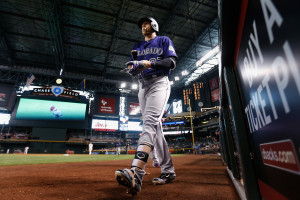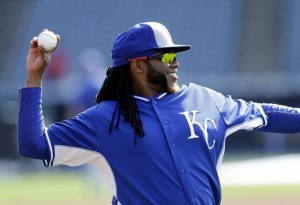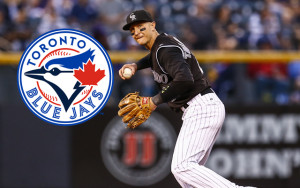
The Colorado Rockies are one of the hardest major league teams to figure this season.
With a win last night over the Pirates, Colorado stayed at just two games behind the Diamondbacks for first place in the National League West. But this season, in more ways than one, has not exactly gone to plan for Colorado.
Going into the year, starter Jon Gray was expected to be the ace of a staff that almost always falters pitching in a ballpark that plays less like a major league stadium and more like a simulation. Gray’s first three months of the season went so well that he was optioned to AAA at the end of June with a 5.77 ERA. Since coming back right before the All-Star break, however, Gray has pitched to a 1.52 ERA in four starts and has gone at least seven innings in each of those games. The Rockies have won all of the games he has started since his return. There is still ample evidence to suggest, despite everything that has transpired, that Gray is Colorado’s best starter. Let’s move over to Colorado’s real adventure, which has been their bullpen.
One wouldn’t think that the bullpen would be the problem area for the Rockies this season given that they spent $106 million on three players as part of a plan to revitalize it. So let’s see how that’s going:
The Rockies spent $106 million on Wade Davis, Bryan Shaw, and Jake McGee over the offseason.
Wade Davis: 5.09 ERA, 4.35 FIP, 6 blown saves
Bryan Shaw: 6.91 ERA, 5.19 FIP
Jake McGee: 6.81 ERA, 4.85 FIP
— David Bote Fan Account (@TheBlogfines) August 4, 2018
It’s almost like giving big contracts to pitchers doesn’t work in Colorado. I’m not a major league GM, but I did stay at a Holiday Inn last night.
At that point, what do you say when you shell out nine figures to three bullpen arms but your best reliever is in the final season of a three-year, $10.4 million deal? None of the pitchers who were supposed to be good for the Rockies this season have lived up to expectations, but the staff has been buoyed by starter Kyle Freeland and reliever Adam Ottavino. Freeland’s numbers suggest that he’s in for a regression sooner rather than later, but to this point in the season, he has saved a Colorado pitching staff that has the eighth-highest ERA in the league.
But let’s get back to the question at the beginning of the article: are the Rockies good enough, as they currently stand, to win the NL West?
Let’s start by looking at their schedule the rest of the way. The Rockies have 17 remaining games with the Diamondbacks and Dodgers, the two teams they’re chasing in the division. They’re only two games back as it stands, so either way, the outcome of these games may very well decide who wins the NL West. To make matters even better, 11 of these games will be at home.
There is another escape hatch for the Rockies if they can’t take their division. In addition to only being two games back of Arizona, they are also just two games back of the Braves for the second and last National League Wild Card spot. Luckily for Colorado, they have a four-game series in Atlanta from August 16-19, and depending on how things develop over the next nine days, the Rockies could set themselves up to leapfrog Atlanta if they take three out of four.
The rest of their schedule, though, is periodically challenging. After home series this week against Pittsburgh and the Dodgers, Bud Black’s team has a two-game set in Houston and the aforementioned Braves series. An easy week follows with San Diego and St. Louis coming to Coors Field, and the Rockies end August and vault into September with road series against the Angels and Padres. The Rockies also have six September games with the Giants, who should be firmly out of playoff contention by the time they face Colorado. The last week of the season, which could decide the Rockies’ fate, will see them host the Phillies for four games and the Nationals for three. Both of those teams could also be fighting for playoffs spot at that point.
If their performance to this point in the season is any indication, however, Colorado is playing in over its head. They have a run differential of -8, and Pythagorean W-L suggests that they should be 10.5 games back in the NL West right now instead of just two. The last team to make the playoffs with a negative run differential was the 2007 Arizona Diamondbacks, and they met their demise in the NLCS at the hands of, you guessed it, the Colorado Rockies. Both Colorado and Seattle are making playoff runs this season with negative run differentials. Seattle is 11-17 in its last 28 games, and if I were a gambling man, I would guess that Colorado would underperform the rest of the way, in spite of the fact that they have overperformed to this point in the year.
There’s also the matter of what the Rockies did, or, more accurately, didn’t do, at the trade deadline. For a team that has multiple needs, particularly with their pitching, making one trade (acquiring Seunghwan Oh from the Blue Jays) probably won’t cut it. Granted, the 36-year-old from South Korea is having an excellent year (2.38 ERA, 2.98 FIP, 9.8 K/9), but he alone may not be enough for the Rockies, especially when you don’t know how he’ll perform at Coors Field (Oh has pitched six scoreless innings for the Rockies since his acquisition). The Diamondbacks got Eduardo Escobar and two solid bullpen arms at the deadline. The Dodgers picked up Brian Dozier and one of the game’s best players in Manny Machado. Comparatively, Colorado got a rock. Pun completely intended.
The Rockies went into this season trying to prove that last year’s Wild Card berth wasn’t a one-off. The jury is still out on that, but Colorado is only two games back on August 7 with 50 games left in the season. That’s a lot of time left for things to go haywire, but it’s also a lot of time for the team to make up a minuscule deficit in their division.
With 17 games left against teams ahead of them in the race, the Rockies will have every chance to compete for a division title. Their underlying numbers suggest that they’re lucky to still be in the race, though.



